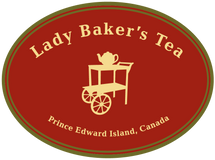Put The Kettle On
By Jane Hastelow
Tea means many things in England. You’ve got your tea biscuits, your tea parties and your tea time, along with your cream teas, your high teas and your afternoon teas. And then you’ve got your run-of-the-mill “put the kettle on” all day long actual tea.
And that’s only a few of them - it can be a little daunting.
Let’s start with the basics - the kettle. It is literally ALWAYS on. In my experience, every time a British person passes a kettle, they put it on. Every time someone shows up at their house, they put it on, and every time there’s a commercial break, they put it on. It is staggering how many tea bags a Brit can go through in the run of a day. And just as staggering is the fact that each cup of tea is generally served alongside the “biscuit tin”, (the closest Canadian equivalent of which would be the cookie jar). Tea is so important that biscuits are generally rated relative to how they hold up when dipped in the tea. Some biscuits are pretty soft, so a very quick graze across the surface of the tea might be all you can manage, while others have a little more staying power and can be rapidly submerged. The highest quality biscuits can manage a more sustained dunk and still not end up in a heap at the bottom of your mug. Preferable, but pricey, especially given the frequency with which the biscuit tin comes out.
Then aside from actual tea, there’s “tea”...let me explain. “Tea” is the meal you eat at about 4pm (tea time). It is typically a light meal, because you had your main meal - “dinner” - at dinner time (noon), and you will probably have “supper” sometime in the late evening. So that’s tea time taken care of - a light meal which may or may not involve actual tea. Not to be confused with afternoon tea, which is a highfalutin affair fit for royalty. It is most likely served in a posh tea room or hotel, and consists of tea in a fine china cup and saucer, cakes, tiny triangular crustless sandwiches and scones. This is a mid-afternoon sort of meal for special occasions, originating, I believe, from the mid afternoon “fatigue” of some duchess or other. One of my favourite places for afternoon tea is Betty’s of Harrogate and York, but you can recreate at home if a trans-Atlantic trip is not in your future!

I’m not going to attempt to explain high tea, because I don’t actually get it, and I think we tend to use it as synonymous with afternoon tea, which, in fact, is not high tea at all, but low tea apparently...hence my confusion.
So moving right along to my very favourite of all the tea events - the cream tea. This does involve a cup of tea, but honestly, tea is not the main event. There’s a scone, usually a beautifully tall, well-risen sultana scone, and there’s jam, and there’s clotted cream. I don’t even know where to begin with the clotted cream - it’s not something that can be adequately compared to anything I know of in North American cuisine. It is made by cooking the unpasteurized milk of Jersey cows for literally days, and it is divine. It is thick and shiny and I know it’s sounds a bit odd but when you add a dollop to your scone and jam, it is a taste sensation like no other. You may have noticed me being a little vague with the jam/scone/cream description, and that is deliberate. The whole cream tea phenomenon hails from the Southwest (Devon and Cornwall), but the Cornish cream tea features the clotted cream on top of the jam, whereas in Devon, they apparently put the jam on top of the cream. I probably shouldn’t play favourites but I can’t imagine putting my clotted cream underneath my jam so, there’s my bias;-)

All in all, tea features heavily in British culture, but not always in the most obvious tea leaves or tea bag kind of way, although that is a staple as well. As a child growing up in the UK, I would have started my tea journey as most British children - we’d be given a little cup of sweetened milk with a splash of tea in it - and I’ve really never stopped drinking tea since. My preference evolved to weak black tea in my twenties, and then to a decade or so of green tea, followed by a period marked by several cups a day of strong black tea with a dash of milk. I now enjoy my decadent tea latte once a day (I make it myself with either Lady Baker Cream Earl Grey or London Fog along with foamed almond milk), and don’t really bother with all the rest anymore.
Unless someone happens to have access to a cream tea with real clotted cream - in that case, please call me asap!

“Yes, that’s it! said the Hatter with a sigh, it’s always tea time.”
– Lewis Carroll, Alice in Wonderland
Jane Hastelow is an educator, former travelling road-schooler, and tea drinker originally from England but brought up in beautiful Prince Edward Island.
Check out Jane's instagram account Road School Rewind for an upcoming Lady Baker's contest.

1 comment
I loved this essay all about tea. The pictures and the tea quotes compliment it nicely, just like a cookie dunked in tea.